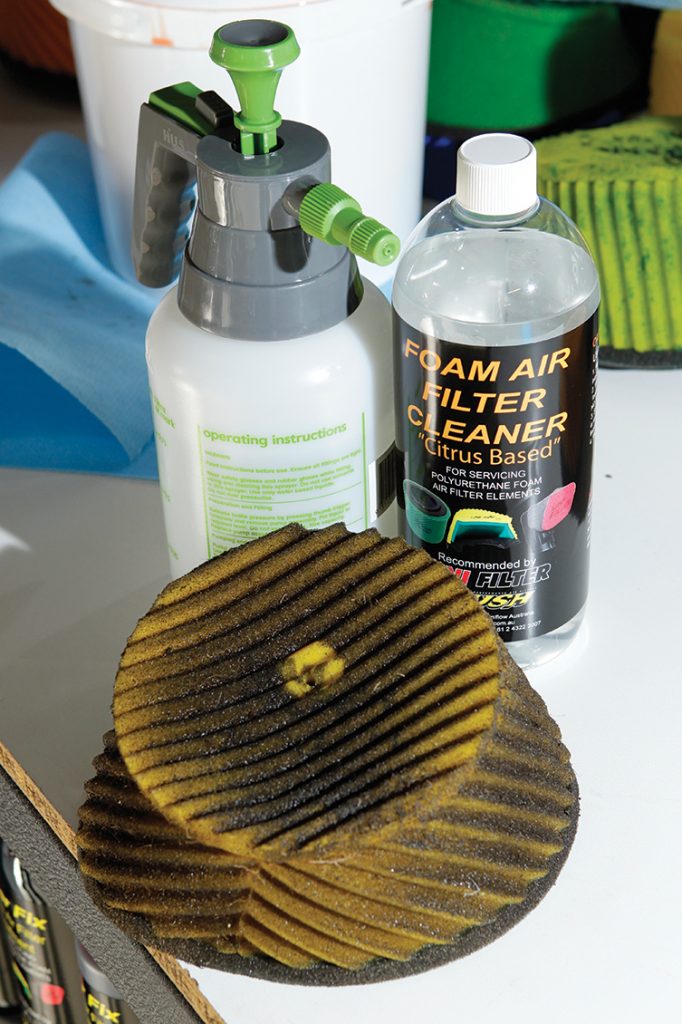Air Filtration: The Misconceptions
Cleaning and re-oiling your bike’s air filter is a crucial maintenance task because, short of writing-off your pride and joy in a crash, the ‘best’ way to destroy a perfectly good machine is a lung full of dust. So, what sort of filter should you be using? How, and how frequently, should you wash it? And what’s the best way to re-oil the thing? We spent a day at Uni Filter’s cutting-edge facility on the NSW Central Coast, and asked the long-time Australian air filtration specialists to set the record straight on some of the most commonly held misconceptions about air filtration.
Filter Foam…
MISCONCEPTION: All filter foam is pretty much the same.
FACT: The quality of foam used in dirt bike air filters differs enormously, but it’s difficult for the untrained eye to see the difference. Cheaper foam tends to be produced by a caustic-type process (the foam is placed in a chemical solution, which is what creates the holes in the foam). It’s generally made in Asia and is much cheaper. Premium foam is made using an acetylene-type process, which involves filling the foam with gas and then blowing it up. Incredibly, only three or four brands around the world use high-quality foam. Filter prices vary from $10 to $60 a pop and, generally speaking,
you get what you pay for.
Both types of foam have similar oil-holding properties, but their longevity differs significantly. Filters that use cheap foam can be ‘spent’ after just a couple of washes. But if you use a filter with high-quality foam, and wash and maintain it correctly, you should get six to 12 months’ use out of it.
MISCONCEPTION: Filters that use a combination of coarse and fine foam are more effective.
FACT: These are known as laminated foam filters. The coarse outer foam is used to compensate for the reduced airflow that’s caused by the lamination process. You can’t pull the two layers apart, and dirt can easily get trapped between the layers and reduce airflow. Other filters use two fine layers of foam, which are not laminated together. They can be pulled apart and properly washed. The lamination process used for the glue seams will also compromise airflow, but this is unavoidable with some bike’s filters. What’s important is that the filter uses flexible seam glue. Some of the cheaper filters use harder glue that, after a few washes, becomes brittle and cracks. After that, the filter soon falls apart.
Cleaning…
MISCONCEPTION: You can use whatever you’ve got on hand to clean the oil and dirt from your filter – turps, metho, petrol, whatever.
FACT: Mineral turpentine, which is oil-based, is the best product to clean foam filters because it is the only 100% safe option for both the foam and seam glue. Any petroleum-based product will affect the foam. You can use it in an emergency, but prolonged use will cause the foam to swell, lose its shape and become loose on the filter cage. It will also make the glue in the seams brittle.
MISCONCEPTION: Always finish off the filter cleaning process with soapy water.
FACT: A lot of soap products have chemicals in them that will affect the foam. If you want to flush any remaining dirt out of the filter after cleaning it with turps, use warm water only. Or, better still, rinse it again in a clean batch of turps.

MISCONCEPTION: The corrugations or spines used on the surface of some air filters are to promote more airflow.
FACT: These shapes increase the filter’s surface area and dirt-holding capabilities, but have no effect on airflow.
Oiling…
MISCONCEPTION: As soon as the filter is clean, it’s ready to be re-oiled.
FACT: It’s absolutely critical that the filter foam is 100% dry before it’s re-oiled. Even if there’s a little moisture left in the foam when you re-oil it, the foam will rot. Ideally, hang the filter
up and allow it to fully dry overnight.
MISCONCEPTION: The more oil you can get into the foam, the better.
FACT: A perfectly oiled foam filter is one that, when you touch it, will only leave a very slight residue on your fingers. In other words, as long as the oil is spread evenly throughout the entire filter, you should get rid of as much excess oil as possible. Uni Filter recommends that you wrap the oiled filter in an absorbent towel or even a clean cloth for half an hour as it’ll help draw any excess oil out of the foam. The benefit of using a coloured filter oil is that you’ll be able to more easily see if there are any sections of foam not carrying oil.
MISCONCEPTION: After oiling the filter, you’ll need to leave it for at least a few hours before starting the bike.
FACT: That’s true if you’re using a synthetic filter oil, which comes with alcohol to make it thinner and easier to apply. You will need to wait for that alcohol to evaporate so the oil becomes tacky. If you don’t wait, it can affect the starting performance of your bike and/or foul a spark plug. If you use a mineral filter oil, however, you can start your bike as soon as you install the new air filter because its oil is already tacky.

MISCONCEPTION: Synthetic oil is better than mineral oil for foam air filters.
FACT: Synthetic filter oil contains lots of additives that bulk up its volume and makes application easier. It’s cheaper to manufacture and is generally only made by companies who don’t make air filters. Mineral foam filter oil, however, is what’s recommended by all filter manufacturers. As mineral oil is thicker, it takes a little longer to apply, by it’s far less inclined to dry out. Even when a filter is laden with dirt, mineral oil has a much greater capacity to remain moist.
MISCONCEPTION: Once the filter is oiled, your job is done.
FACT: Using a layer of grease around the seating edge of the filter is an extra precaution well worth taking because airboxes often go out of shape after being exposed to exhaust heat. It doesn’t matter how well a filter is oiled if dirty air can get between the filter and airboot.
MISCONCEPTION: One well-maintained filter will be enough for the average rider for years.
FACT: If you ride regularly, you should ideally have two to three filters on rotation. The more you turn them over, the longer they last. If you only ride once every month or two, your filter won’t last as long as if you ride and cycle your filters more regularly. This is because, just sitting in your shed or garage, the filter will attract moisture and that will accelerate the deterioration of the foam. Moisture is the biggest killer of a filter foam.
Check out this video insight into Uni Filter’s mechanically assisted filter oiling technique.
This content was originally published in Transmoto’s print magazine in Jan-Feb, 2015 (Issue #48).












Be the first to comment...